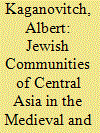| Srl | Item |
| 1 |
ID:
192971


|
|
|
|
|
| Summary/Abstract |
In this article we will consider the language policy the Soviet authorities directed toward the Bukharan Jews in Uzbekistan. These reforms were carried out in several stages. Initially, traditional Hebrew education was banned in favour of the Judeo-Tajik language. Then, in the late 1930s, it was the turn of the ban in favour of the Russian, Tajik and Uzbek languages. At the same time, the national schools of the Bukharan Jews were liquidated. All this, as well as the alphabet of education, changed twice in the 1930s, harmed the level of education of Bukharan Jews. As a result, many Bukharan–Jewish children could not handle the language innovations and began to study worse or even stopped attending public schools. Concerned about this, the authorities were forced to temporarily restore Bukharan–Jewish schools and classes with Judeo-Tajik or Tajik language instruction in the mid-1940s. This history shows that the Soviet authorities carefully monitored the reaction of the population and were able to show flexibility in matters that were not points of principle.
|
|
|
|
|
|
|
|
|
|
|
|
|
|
|
|
| 2 |
ID:
168992


|
|
|
|
|
| Summary/Abstract |
When the Jews first settled in Central Asia is uncertain, but circumstantial evidence clearly indicates that this happened at least two and a half thousand years ago. In the first millennium AD, the Jews lived only in cities no farther than 750 km east of the Caspian sea (in the eighth–eleventh centuries the sea was called Khazarian). Only later did they migrate to the central part of the region, to cities like Samarkand and Bukhara. It is possible that Jews from Khazaria joined them, since they already had tight trade connections with Central Asia and China. There is no trace of evidence regarding the existence of Jews in the entirety of Central Asia in the early sixteenth century. At the very end of the sixteenth century Bukhara became the new ethnoreligious center of the Jews in that region. In the first half of the nineteenth century, thanks to European travelers visiting Central Asia at that time, the term “Bukharan Jews” was assigned to this sub-ethnic Jewish group. Drawing on a wide range of primary and secondary source materials, this article aims to prove that the presence of Jews in Central Asia was not continuous, and therefore the modern Bukharan Jews are not descendants of the first Jewish settlers there. It also attempts to determine where Central Asia’s first Jewish population disappeared to.
|
|
|
|
|
|
|
|
|
|
|
|
|
|
|
|